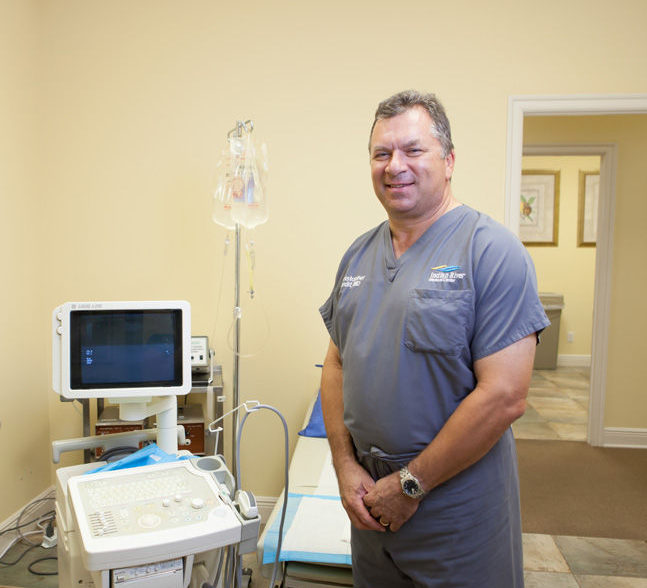
It’s a topic no one really likes talking about – except possibly the folks at Kimberly-Clark, the manufacturer the “Depend” brand undergarments – but the Urology Care Foundation reports that over 15 million American men and women suffer from some form of urinary incontinence.
There are several different forms of urinary incontinence and their severities range from occasionally leaking tiny amounts of urine during a cough or sneeze all the way up being unable to make it to a toilet in time and suffering the thoroughly warm and wet consequences.
Dr. Christopher Tardif, a graduate of the University of North Carolina medical school, who served his internship and residencies at Washington, D.C.’s George Washington University Hospital has been helping Vero residents deal with all forms of incontinence since joining the Indian River Medical center back in 2000.
Incontinence, says Tardif, “is a medical condition or a disease. It can be a problem in and of itself. It can also be a sign of another, underlying problem.” However, Tardif says reassuringly, “If evaluated and treated properly,” this all-too-common condition can be effectively treated.
Types of urinary incontinence include, but aren’t entirely limited to, “stress incontinence” during which urine leaks when coughing, sneezing, laughing, exercising or lifting something heavy. “Urge incontinence,” meanwhile is the intense need to urinate coupled with the inability to stop the flow. This can be caused by relatively minor conditions – such as infections – or more severe problems including neurologic disorders and diabetes.
What’s known as “overflow incontinence” is generally marked by frequent or constant dribbling of urine because the person’s bladder never really empties completely and in “functional incontinence,” a physical or mental impairment such as an ankle injury or arthritic hands that can keep people from making it to the nearest toilet in time or, if they do, they’re unable to unzip or unbutton in time.
According to the National Institutes of Health, women experience urinary incontinence twice as often as men.
Pregnancy and childbirth along with menopause and even hysterectomies all help stack the deck against women. Pregnancy and childbirth can weaken the muscles needed for bladder control and also damage bladder nerves and supportive tissue. Meanwhile, after menopause, women produce less estrogen, a hormone that helps the lining of both the bladder and urethra stay healthy and any surgery involving a woman’s reproductive system, such as a hysterectomy, can damage the supporting pelvic muscles leading to incontinence.
Men, cautions Tardif, are by no means entirely off the hook when it comes to incontinence. “We see a lot of stress incontinence in both men and women and overflow incontinence in men with prostate problems,” he explains. What’s more, Tardif estimates, “35 to 50 percent (of the general public) may develop incontinence” but he rejects the idea that sooner or later everyone will experience it. The odds of developing some form of incontinence, Tardif says, “certainly increase with age but it’s not inevitable” and, he adds, it is not something to be embarrassed about.
“I always tell my patients,” the former Tar Heel and Colonial continues, “it’s a ‘quality of life’ problem that can be dealt with.”
“People have heard or been told by friends or family members that there’s nothing that can be done,” Tardif states bluntly, “but that’s just not true.”
For starters, simple lifestyle choices can help reduce or eliminate the problem. Certain drinks, foods and supplements can stimulate the bladder and thereby increase a person’s volume of urine. Alcohol, coffee, decaffeinated tea, carbonated drinks, artificial sweeteners, citrus fruit and even large doses of vitamins B and C are some of the most common culprits.
While Tardif seems less than impressed with the over-the-counter medications being sold to treat incontinence, he says there are some very effective Food and Drug Administration-approved prescription drugs on the market. He then adds, “it’s important for a doctor to do an evaluation,” so the correct type of incontinence can be diagnosed and the proper prescription written.
Tardif doesn’t appear to view that as a potential turf battle. “Most general practitioners,” the urologist with a lifetime certification from the American Board of Urology says, “should be able to make a good diagnosis,” though he admits many patients do come directly to him.
If medications fail to solve the problem Tardif says there are other techniques that can.
“One of the things that just got approved by the FDA,” the affable Tardif continues, “is Botox injections into the bladder.” Botox (botulinum toxin) can be used to relax overactive muscles in the urinary system while another new FDA-approved procedure is “sacral nerve stimulation” which might be best described as a kind of electronic “pacemaker” for the bladder.
Tardif adds there are also “gold standard” surgical procedures available as well. For women, pubovaginal sling implants can be used to take pressure off the urethra. This minimally invasive procedure is much different from the “synthetic mesh sling” surgeries talked about on TV commercials by various lawyers in no small part because Tardif uses “biological” slings and not the synthetic mesh versions of several years ago.
Still, the single most important thing for patients to do, according to Tardif, is to be candid with their primary care doctor or their urologist and make their expectations clear. Once a course of treatment has been decided upon, he says, both physician and patient have an excellent chance of meeting their goals for a drier life.
Dr. Christopher Tardif is at 3745 11th Circle, Suite 103 in Vero Beach directly across from Indian River Medical Center. The phone is 772-794-9771.



